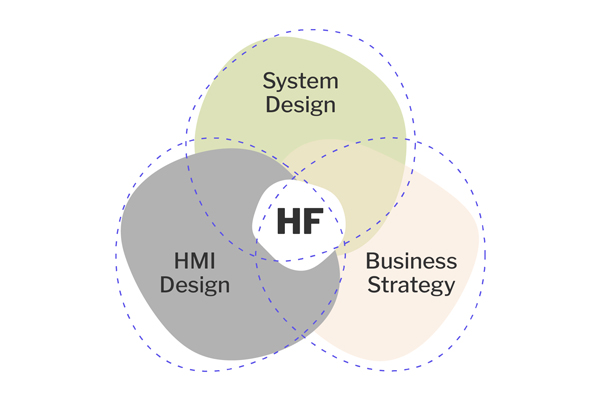Can Human Factors be Applied to Operations and Systems That Include a Human-Machine Interface?
We were recently approached by someone at a Human Factors (HF) conference who asked me if HF can be applied to an industrial workplace with operations consisting of a human-machine interface. It got me thinking: what are the circumstances in which we would want to do this? And how can we do this?
Traditionally, HF is typically known for its application to the design, development, and evaluation of medical devices and even consumer-based products. But what about its application to the operational workflows of an industrial work environment? This environment can be a corporate setting or an active industrial production environment.
Productivity in the modern workplace requires attention to human behavior, cognition, and interaction. Competitive companies must understand how individuals engage with other people, their environment, tools, the information they receive, and their tasks. This article will provide a clearer lens through which businesses can leverage human factors practices to optimize human performance and operational workflows for the human-machine interface and ensure harmonious synergy between employees and their work environment.
The Importance of Human Factors in a Workplace with Complex Human-Machine Interfaces
In today’s dynamic work environments, the role of HF is pivotal, weaving its influence across various facets of organizational function, from system design to Human-machine Interface (HMI) design and business strategy.
Enhancing Efficiency and Productivity: By aligning real-world systems and processes with human capabilities and limitations, HF improves the interface between employees and their tools, other people, information, and their environment. This streamlines tasks, reduces variability, and fosters heightened efficiency in employee roles, resulting in increased productivity levels and improved operational flow.
Reducing Errors and Increasing Safety: Human error, which can have significant consequences on production and employee safety, can be significantly reduced by understanding and incorporating human capabilities, limitations, and behaviors into human-computer interaction (HCI) and information systems design. Integrating HF principles into workplace design empowers organizations to proactively identify and address potential pitfalls, creating safer and more efficient workspaces with reduced errors.
Fostering Employee Satisfaction and Well-being: At its essence, HF acknowledges that there is an entire system at play, one that consists of people, the work environment (from several perspectives, including cultural background as well as physical environment that considers influencing factors, such as temperature, humidity, and the like), tools, devices/machinery, and information.
Applying Human Factors Engineering to the Workplace Evaluation of Human-Machine Interfaces
To achieve excellence and efficiency, organizations must align work processes and environments with their most vital asset: the human operators. Applying Human Factors in evaluating the workplace offers valuable insights to bridge the gap between operational demands and human capacities, resulting in smoother, more efficient operations. By placing more emphasis on HF and the end user, organizations can optimize productivity and create an environment that maximizes the potential of their workforce.
Understanding Employee Capabilities and Limitations: Before developing a workplace strategy and accompanying user experience, assessing employees’ strengths and potential vulnerabilities in real-time is crucial. Learning about the human operators’ cognitive, physical, and emotional capacities to customize work assignments and responsibilities and align with an employee’s inherent abilities. Adopting this strategy ensures that productivity and efficiencies are improved when the task appropriately fits the intended end user.
Creating an Inclusive and Ergonomic Work Environment: A workspace that prioritizes the physical well-being of its occupants can significantly enhance productivity and minimize work-related injuries. Adopting an employee-centric approach to workspaces and tasks that implements ergonomic principles, such as adjustable chairs, adequate lighting, and customized workstation layouts, fosters an environment that promotes health and maximizes efficiency. HF can even help to design technology to support workflow optimization.
Improving Presentation for Better Performance: What and how the information is conveyed and the format in which it is presented can profoundly affect employees’ perceptions and how they react to that information. There is also a cultural component here; for example, different cultures have different norms for how people should address each other. Take a pilot and a co-pilot dyad, for instance. Here in the US, first officers are not afraid to speak up and correct their captains if their captains make an error. However, correcting an elder or someone of higher authority can be disrespectful in other cultures. This cultural norm could be a root cause for a crash–if the captain made an error, and the first officer doesn’t say anything or correct the mistake out of their cultural norms of respect, it could have catastrophic consequences.
Methods and Tools for Applying Human Factors
Applying the practice of Human Factors (HF) to the design process in the industrial workplace requires a versatile and comprehensive toolkit that aligns with the diverse nature of the human experience. By combining conventional methodologies with state-of-the-art technologies, organizations can gain profound insight into the interactions between their workforce, environment, and information systems. Let’s explore some essential methods and tools for seamlessly integrating HF into the workplace.
Cognitive Task Analysis: This approach focuses on exploring employees’ cognitive processes. Organizations can optimize work processes to align with innate cognitive patterns by analyzing task performance, decision-making, problem-solving, and information processing.
Surveys and Interview with Employees: Surveying and interviewing employees about their work tasks, their ways of working, what works for them and doesn’t work for them, and their ideas for improving operational workflows serves as a source of rich information for understanding current operations and identifying opportunities to improve them.
Evaluation and Observation: By observing employees’ interactions with other people, information, tools, and the environment around them, organizations can identify areas of friction or inefficiency. Observation can yield insights that are not discovered through interviews and surveys.
Work Simulations and Prototyping: Before implementing substantial changes in the workplace, it is prudent to conduct preliminary testing. Employing simulations or prototypes enables organizations to simulate potential scenarios or solutions, creating a risk-free setting to assess their effectiveness and identify areas for improvement.
Advanced Technologies: With the continuous evolution of technology, the tools for HF analysis have advanced significantly. Cutting-edge techniques such as eye-tracking can provide valuable insights into employees’ visual engagement with their surroundings, shedding light on critical focus areas and potential distractions. Meanwhile, wearables offer the ability to monitor physical strain and stress levels, ensuring that the workplace prioritizes the well-being of individuals. Additionally, HF allows us to think about where automation can and should come into place to take over specific tasks. A robot and human combination may be more productive and efficient than a human or robot alone.
Root Cause Analysis (RCA): You can also understand where people are not as productive, make mistakes, or if safety is compromised. By doing a root cause analysis, you can determine the root issue causing these problems and work to address them through mitigations, whatever those may be.
Benefits and Potential Outcomes of Applying Human Factors to Work
When seamlessly integrated into an organization’s operations, HF practices can improve human-machine operations, make the whole workplace function more fluidly, and increase production. HF can leverage the understanding of cognitive and physical limitations and capabilities and the study of how people interact with the environment, devices, information, and other people to improve workflows, operating efficiencies, and usability between humans and machines. Operations is a relatively untapped area where HF can enhance the system’s usability instead of just the individual human.
Improved Employee Performance: At its essence, Human Factors (HF) aims to optimize work processes and environments to align with human abilities and limitations. Employees can perform their best by eliminating operational inefficiencies caused by inadequate tools, information and its flow, complex processes, and environmental factors, and the organization can benefit from heightened productivity.
Enhanced Organizational Effectiveness: A workplace optimized with Human Factors (HF) principles experiences reduced errors, streamlined processes, and a harmonious workflow. When an organization’s individual components operate efficiently, its collective machinery excels in effectiveness, propelling its goals and vision forward.
Potential Cost Savings and ROI: Reducing errors results in improved safety and less time focused on identifying, implementing, and evaluating rectifications. When combined with optimized work processes, the financial advantages become apparent. Although there may be an initial investment in HF assessment and implementation, the return on investment, including tangible cost savings and intangible benefits such as reputation, can be significant.
By implementing Human Factors Engineering into the workplace, you can create an inclusive and ergonomic environment that supports employees with understanding their capabilities and limitations for improved performance. Everyone stands to benefit from Optimal Usability and Accessibility Initiatives, which result in enhanced organizational effectiveness, potential cost savings, as well as ROI. As the importance of user-centered design continues to increase across industries, Human Factors Engineering has become an essential tool to ensure employees are presented with the best possible conditions, leading to improved business outcomes. Therefore, organizations need to take steps toward human factors initiatives if they want their projects to succeed and reach peak efficiency. Designing a workplace around human capability will bring value by enabling workers to do their best work – use Human Factors Engineering today and reap the rewards!
______________________________________________________________________________
HUMAN FACTORS ENGINEERING AT THRIVE
THRIVE’s Human Factors professionals have decades of experience applying Human Factors to products ranging from medical devices used by specialized healthcare professionals in clinical environments to combination products used by laypeople in the home.
If it’s your first time applying to Human Factors and you need a comprehensive end-to-end Human Factors program, we’ll scope out the program and conduct the activities on your behalf, leaving you time and resources to focus elsewhere. If you’re a resource-constrained HFE professional, we’ll provide the teamwork, collaboration, and support to help you meet your goals. Or, if you want a final sanity check to ensure you’ve met the latest and greatest expectations, we’ll do that, too.
Contact us today at 404.228.7342 or email [email protected] to get the conversation started.
Atlanta | Chicago












